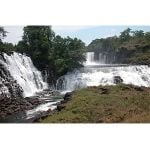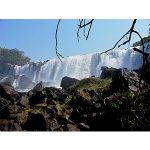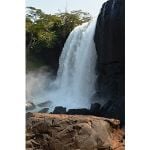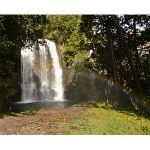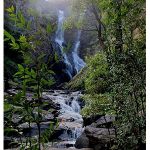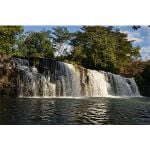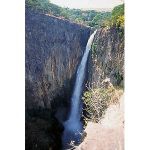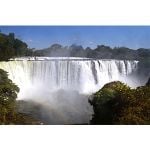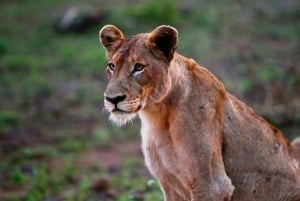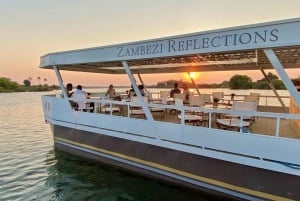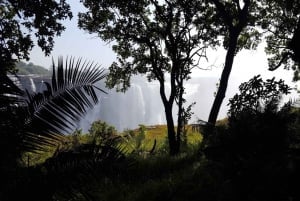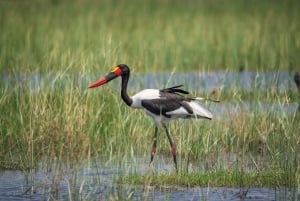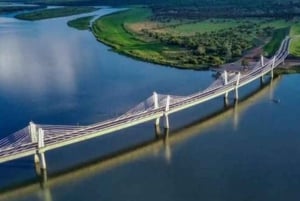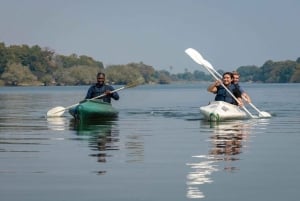Waterfalls
With 40 percent of Sub-Saharan Africa's water and 30 percent of that in the Luapula province Zambia has abundant water. Couple that with a number of beautiful waterfalls, predominantly in Luapula and Northern provinces and you have a largely unknown treasure trove of beautiful locations.
Kundalila Falls (13°09'09.6"S 30°42'03.6"E).
The visitors centre is certainly not one of the nice new versions found at some of the other falls and the long-drop toilets are an experience best avoided if possible.
The caretaker led us down the path, over the narrow bridge across the Kaombe River, a brief stop to admire and photograph the spectacular view out over the Luangwa Valley, follow the right hand fork in the path, to the first viewpoint. A lovely, if slightly scary spot as there are no guide rails or walkways. Plans are being made for improvements including better safety precautions.
Return to the fork and take the other path to the bottom of the falls. I would advise anyone with less than average fitness to consider this with care. The climb down is steep and a bit tricky. The climb back out is quite taxing, there are no steps and only a rough rocky path. But, it is worth it. The narrow falls plummets down 70 meters and into a beautiful clear pool. Swimming is permitted but the water is jolly cold.
The falls face east so, in the early afternoon the sun is behind the falls making photography very difficult. Early morning would be ideal.
Camping is permitted but there are no facilities.
Ntumbachushi Falls
(9°51'00.0"S 28°56'00.0"E)
Ntumbachushi on the Ng’ona River, is just off the Kawambwa-Mbereshi Road, 22Km from Mbereshi, has a number of beautiful cataracts and small falls upstream of the main falls. The main falls, which splits into two cascades in the lower water, plummets 30 meters into a beautiful pool surrounded by a small rainforest. A short distance downstream there is a rather questionable bridge over the river, you back track upstream and come to the secondary cascade. This falls onto rocks and creates an exciting natural shower. Rather chilly but very invigorating.
If you are the only visitors you can camp at the base of the main falls and be rocked to sleep by the sounds endlessly falling water.
A new visitors centre was being built (June 2014).
According to the caretaker James, Ntum means mountain and Bachushi means smoke or mist/spray.
This is a sacred site where a new chiefs bath before being installed on the throne.
Mumbuluma Falls (10°55'47.2"S 28°44'09.0"E)
32Km North of Mansa to the turnoff and then 8.4Km of reasonable dirt road. Abraham, the caretaker is very proud of his waterfalls and is delighted to show you around. There is a new visitors centre with clean flush toilets but no showers. (2014)
The falls cascade down in two steps on the Mumbuluma River.
Camping is permitted. There are no showers but swimming is allowed. The water is quite chilly!
Lumangwe Falls (9°32'00.0"S 29°23'00.0"E)
The Lumangwe Falls on the Kalungwishi River are positively spectacular. 35 meters high and 100 meters across. There 3 different areas to view the falls, directly in front, from the top and from the bottom. There is a well-built flight of stone steps going down through beautiful rainforest plants and dripping rocks to a viewing platform at the bottom of the falls which is well worth the climb. The top of the falls has no guide rails and so it is up to the visitor to exercise caution.
There is a campsite and ablution block but sadly the taps have been broken and, in some cases, not even plumbed in which is quite disappointing.
The falls are 80 km from Mporokoso on the Kawambwa road. In June 2014 this was a dreadful road and very slow going. It is being tarred and should hopefully be better in the near future.
Kabwelume Falls (9°31'24.2"S 29°21'09.6"E)
Five kilometres downstream of the Lumangwe Falls on the Kalungwishi river, the Kabweluma Falls can be found in three powerful cascades, each spilling into the next. Beneath the falls there is a thickly wooded ravine and some ancient paintings adorning nearby rock faces beneath a permanent rainbow. The road from the entrance to the reserve was very bad (June 2014) and the caretaker Cecelia did not seem to feel that this was a problem.
Chishimba Falls (10°06'30.1"S 30°55'02.9"E)
33Km from Kasama on the Luombe River is the Chishimba Falls. The falls are well signposted from the Kasama – Mporokoso road. The area has a bar and restaurant and is quite a popular weekend spot for Kasama residents.
Camping is permitted and, although there were no showers, the toilets were clean and swimming was permitted.
From the campsite/car park you cross a canal, part of the ZESCO hydroelectric scheme, and follow the path downstream.
The Kaela Rapids are a pleasant spot on the well maintained path, one of a number of thatched gazebos.
The Chishimba Falls are about 300m from the campsite. A 30 meter drop over a dark rocky over crop. The falls can be viewed from the top and like most of the more remote falls in Zambia, there are no safety rails so caution must be exercised. The view out over the valley from the top is quite spectacular. There is a flight of uneven steps to the bottom of the falls. From this vantage point you can admire the huge craggy rocks.
The Mutumuna Falls are found upstream of the camp site.
Mutumuna Falls (10°06'30.1"S 30°55'02.9"E)
A short way upstream of the Chishimba campsite, approximately 360m, are the Mutumuna Falls. Follow the well maintained path along the river to the falls. Approximately 20m high these are still a spectacular sight.
A hydroelectric scheme has been built above the falls but this in no way upsets this picturesque spot.
Kalambo Falls (8°35′47″S 31°14′25″E)
The Kalambo Falls on the Kalambo River, at 221 meters, are the highest waterfalls in Zambia and the second highest uninterrupted waterfall in Africa. Like the Victoria Falls the Kalambo Falls is a cross-border waterfall, shared iwth Tanzania.
The water plunges over the cliff into the gorge below, peer over the edge with care. The view from the top over Tanzania is spectacular.
The Kalambo area is also an important archaelogical site with evidence of Stone Age and early Iron Age occupation, including evidence of the use of fire. For many years this was the earliest evidence of fire in sub-Saharan Africa.


